| The early history of airgunning is often shrouded in mystery and yet is as intriguing as any chronicle of centuries gone by. Although it is difficult to ascertain exactly when airguns were first produced in Europe, historians now believe the mid-1500's was the most likely period for their first appearance. Comparatively few specimens have survived the slow march of time, and most of those airguns which did now repose in arms museums throughout the world. We do know that since their earliest days, airguns were often misunderstood and even reviled as tools of the Devil (similar to the way target pistols are now treated in the 21st century). Considering the fact that some airguns of bygone centuries were usually of very large caliber and almost as powerful as the firearms of the day - albeit without the deafening noise, flash and smoke - it is easy to understand why the airguns of the time were feared by many. Most of the earliest airguns belonged to two different groups, those powered by spring loaded bellows and those utilizing precompressed air stored in a reservoir, which was either an integral part of the gun or attached to it. Bellows guns were generally intended for target shooting indoors. Although low powered, they were amazingly accurate at short ranges. Pneumatic guns, on the other hand were relatively powerful. The technology of these guns gradually improved over the years and their use in hunting became fashionable among the European nobility. The fact that game as large as wild boar and stag was routinely taken by these early pneumatic guns demonstrates their amazing power. Their relatively quiet and efficient operation, coupled with their imperviousness to rain or snow, made them very desirable weapons indeed. For these reasons commoners were often forbidden from owning airguns. Early airguns production in the United States centered around the "gallery gun", a relatively low powered gun utilizing a spring piston power plant. These guns flourished during the period immediately following the Civil War and were used mainly for shooting at paper targets indoors. As the 19th century came to a close, the calibers of airguns of both America and Europe had been scaled down considerably. The 20th century witnessed tremendous strides in the field of adult airguns, especially since the end of WWII. Many German factories turned to airgun manufacturing after firearms production was prohibited by the occupying Allies. This sport has seen the creation of a major new industry which claims a significant share of world-wide shooting sports today. The erroneous concept of airguns being mere toys has been fostered by years of exposure to the ubiquitous BB gun; however, word of mouth and the fact that airgunning is now an Olympic sport are rapidly causing this image to disappear. The ultrasophisticated recoilless match airguns, capable of single hole precision at 10 meters, can hardly be called "toys". The 1984 Olympic Games featured airgunning for the first time, a historic and dramatic indication of the importance of ariguns in today's recreational shooting. Likewise, air rifles capable of shooting .177 caliber pellets at 1000+ feet per second have vaulted the airgun into the serious sporting arms class. Adult airguns have finally become truly universal, a shooting sport that can be enjoyed by anyone, anywhere - a far cry from their murky, uncertain beginnings a few short centuries ago. |
| Target Pistol Evolution - 3 |
 |
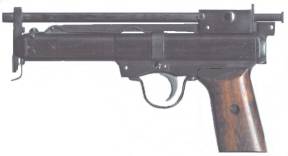 |
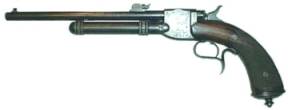 |
 |
 |
 |
 |
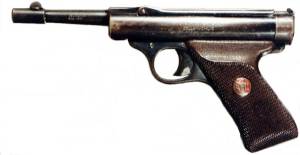 |
 |
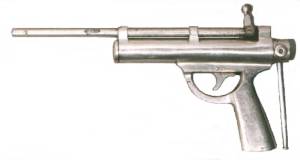 |
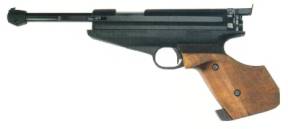 |
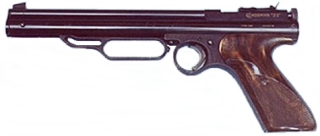 |
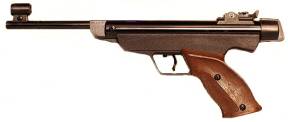 |
 |
 |
 |
 |
 |
 |
 |
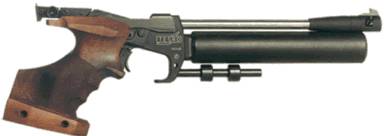 |
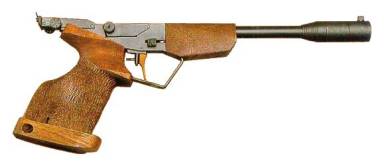 |
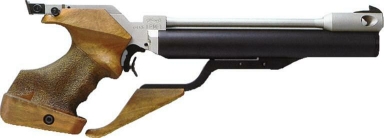 |
| German Eisenwerke Air Pistol 1880 Spring Operated, Break Barrel Cocking |
| Swiss Tell 1 Air Pistol c 1870 Spring Operated, Break Barrel Cocking |
| German Titan Pneumatic Air Pistol late 19th century |
| US Lincoln Pneumatic Air Pistol Late 19th Century |
| British Carbonic Gas Air Pistol c1890 |
| British Webley Mark 1 Pneumatic Air Pistol Early 20th Century |
| German Haenel Air Pistol Spring Operated - 20th Century |
| German Centus C+H Pneumatic Air Pistol early 20th Century |
| Swiss Tell 203 Spring Operated Air Pistol. Early 20th Century |
| Mid to Late 20th Century Air Pistols |
| US Crosman Pneumatic Air Pistol |
| German RWS Spring Operated Air Pistol |
| German Walther LP3 Pneumatic Match Air Pistol |
| German Feinwerkbau 65 Spring Operated Air Pistol |
| Swiss Hammerli Master Compressed CO2 Air Pistol |
| Swedish/US Crosman Skanaker Compressed CO2 Air Pistol |
| Present Day Air Pistols |
| German Feinwerkbau Pneumatic Air Pistol |
| Russian IZH 46M Pneumatic Air Pistol |
| German Walther LPM1 Pneumatic Air Pistol |
| Czechoslovakian BRNO Tau 7 Compressed CO2 Air Pistol |
| German Tesro PA 10 Compressed Air, Air Pistol |
| German Feinwerkbau P34 Compressed Air/CO2 Air Pistol |
| Italian FAS 609 Master Compressed Air, Air Pistol |
| German Anschutz Compressed Air, Air Pistol |
| German Walther LP300 Compressed Air, Air Pistol |
| Swiss Hammerli AP 40 Compressed Air, Air Pistol |
| The majority of air pistols in the mid 20th century up to 1980 were of the spring operated or pneumatic types. The German Feinwerkbau Model 65 was the first of an illustrious lineage that won medals at World Championships on a regular basis. This pistol is still popular today. The manually cocked pneumatic pistols are still popular amongst top shooters but are not favoured by most shooters due to the cocking effort required. |
| The Hammerli Master air pistol utilised CO2 sparklets of the type used in soda syphons. It was a remarkably accurate pistol but its sparklet would only provide sufficient propellant for one match of 60 shots plus some sighters. It is no longer manufactured |
| The Crosman Skanaker compressed CO2 air pistol was designed by the Swedish World and Olympic Champion, Ragnar Skanaker and developed and produced by the US Crosman firm. This was a landmark pistol which established the parameters for all modern compressed CO2/Air pistols in use today. |
| Single stroke pneumatic air pistols are still popular today and great strides have been made in reducing the cocking effort required. The Russian IZH 46M pistol is gaining popularity amongst new shooters in the USA in particular, due to its excellent accuracy, fine trigger and low price. The European pneumatics are made from aircraft grade aluminium and boast superb accuracy and triggers and fully adjustable sights.. |
| The BRNO Tau 7 is interseting in that it is in many ways similar to the old Hammerli Master. Instead of usiing a sparklet of CO2 gas, a small tank in the grip of the pistol is filled from a larger tank. It is an accurate pistol and is popular as an entry level pistol. |
| The following pistols are regarded as some of the top of the range target air pistols and are used by champion shooters world wide. They are beautifully made, capable of firing all of their shots through the same hole, have fully adjustable and quite sophisticated sights and the best match grade triggers. Regrettably they are expensive, costing in the $2000 to $2500 range. |
 |
| Mens Air Pistol Finals - Sydney Olympics |
| Air Pistol is now high tech. At major competitions, shooters fire their shots at "virtual" electronic targets, instead of paper ones. These electronic targets accurately locate the shot position accoustically and give an instant display of the shot and the score on the shooter's individual monitor. Targets are located 10 metres from the firing line. |
| The Air Pistol |
